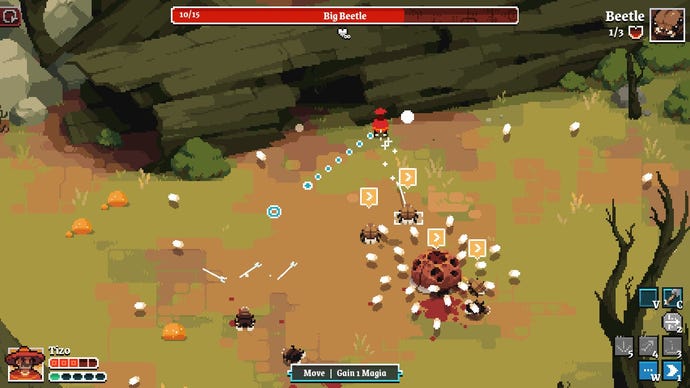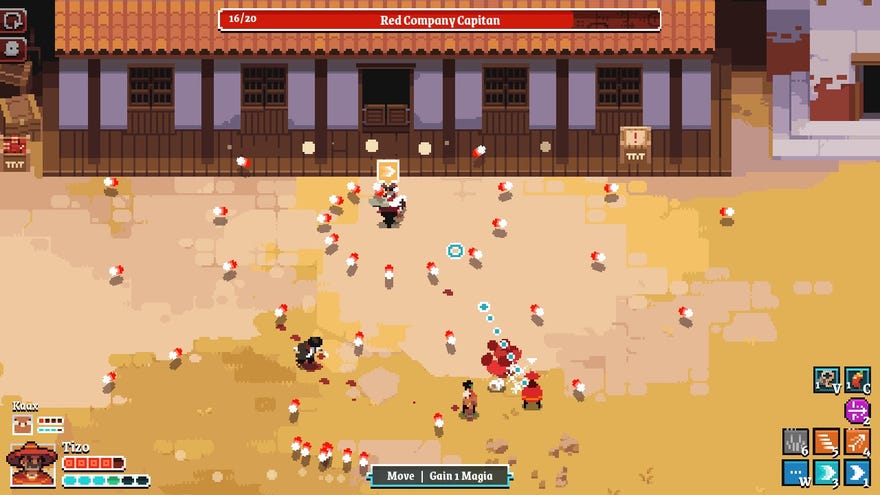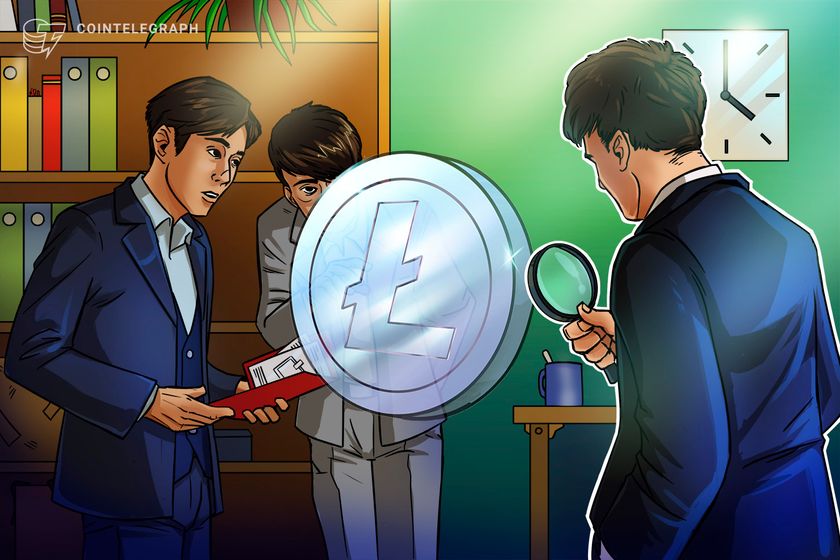There are many reasons to play and write about Arco. The Mesoamerican pixelart landscapes, for example - radiant, cloud-hung platters of land with people and buildings reduced to daubs of paint in the foreground. The fact that it's about witnessing and surviving colonial invasion, rather than the more familiar European or North American video game fantasy of searching a New World for plunder.
The ensemble storytelling, with four, successively playable characters setting their own lenses to thickly entangled themes of sorrow, vengeance and growing understanding. The sparse, expressive dialogue, each phrase carefully tucked inside its speech bubble. The music. And the little things at the level of how you move, what you do. When you pick a faraway destination on your map, your character makes the journey screen by screen, which gives you a second to lean back and be a passenger, watching the horizon, at least until you're ambushed by a giant beetle.
Still, I don't feel comfortable talking about a lot of Arco, because I haven't finished the game. It launched during the busy season around Gamescom, and slipped under our radar despite Katharine's (RPS in Peace) fierce enthusiasm for the preview build. It's not a massive game but it's also not one I'm inclined to rush: I'm only in the second of its five acts. Still, I feel the itch to write about it, not least because it deserves to sell a lot better than it currently is. So let me focus on something more immediate and transferable, the battle system, and why I like it so much.
Arco's battles take place in single-screen arenas with a smattering of interactive terrain fixtures, like grouchy plant bulbs that fire needles in a 360 degree arc when bumped. Battles are broken into pauses, rather than turns, with characters, enemies and projectiles frozen in place while you make choices. During each pause, you can pick movement trajectories and aim abilities using points, which gradually replenish; you can also wait on the spot to restore a bunch of points in one go. You can also visualise where enemies are heading and what action they'll perform next.
Given that you are often outnumbered and outgunned - you don't even have a gun, in the acts I've played - survival becomes a question of evading in a way that sets you up to attack. Keep pulling back, keep skirting the perimeter, and you'll be relentlessly zoned or swamped. Instead, you must surge forward and thread the gaps in the offensive, pouncing when attackers reload or performing abilities that interrupt them. You must kite the sword-wielding conquistadors while manouevring toward the gunslingers positioned behind them.
There's a sobering narrative dimension to all this. Your character's feelings of guilt - accrued as you take on quests and pick an imperfect path through a landscape of bigotry and violence - appear as chattering spectres who operate in real-time. They creep towards your character while you're setting move paths and choosing abilities, eroding the sanctuary which turn or pause-based games traditionally offer. I'm getting ahead of myself, but it's a clever show of how characterisation and plot might invade the ostensible "purely" mechanical space of combat: the more stained and polluted you feel by Arco's bloodshed, the less time you have to think.
It took me a while to work out what all this reminded me of. At first, my thoughts drifted to ancient PSX RPG Grandia, and there's probably something in that comparison. But the breakthrough, for me, was when I realised that I wasn't playing an RPG, but a top-down shooter. At its most vicious, a bullet hell shooter: Arco has bosses who vomit giant, splashy rounds in all directions, and avoiding them while avoiding other hazards (such as grumpy plants set off by those rounds) takes science. Don't get me wrong, it's not Crimzon Clover. But it tickles the same bits of my brain.
 Image credit: Rock Paper Shotgun/Panic
Image credit: Rock Paper Shotgun/Panic
Or at least it would, if I were any good at bullet hell shooters. I love looking at these games, at their devious and obliterating polychrome patterns. I love racking my brain about how the designers arranged the flying pieces such that there is, in fact, a milimetre-wide safe route for the player that also somehow allows you to fire back at whatever screen-sized juggernaut is in play. But playing them, I'm too zoomed in on my ship, bucking and bouncing like a leaf thrown into boiling water, to appreciate the spectacle.
I'm coming at it from a dabbler's perspective, but it seems a minor tragedy that a genre that lends itself to such opulent lightshows should be so tricky to enjoy as a lightshow without perishing instantly. I guess that's the point of Gitting Gud here: the more versed you are, the more you can carve away the overwhelm and see the game you're engulfed in.


I like Arco's combat system, then, because it has given me an opportunity to play something mildly bullet-hellish and actually enjoy the view. I can trace the thinking behind each arena's arrangements of bullets and cover and terrain hazards, considering the setup as a whole without biting the dust - at least, until I'm literally enveloped by my own feelings of self-loathing and remorse. It's inspired me to go looking for shmups and bullet hell games in which freeze time is a core mechanic, rather than a fleeting power-up. There must be a few, right? Let me know.
Find Arco on Steam.

 1 month ago
6
1 month ago
6









 English (US) ·
English (US) ·